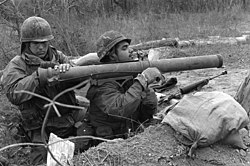M67 recoilless rifle
| M67 recoilless rifle | |
|---|---|
 The M67 recoilless rifle | |
| Place of origin | |
| Specifications | |
| Mass | 37.5 lb (17 kg) |
| Length | 53 in (1,346 mm) |
| Height | 17 in (432 mm) |
| Crew | 3 |
| Caliber | 3.54 in (90 mm) |
| Muzzle velocity | 700 ft/s (213 m/s) |
| Maximum firing range | 2,300 yd (2,100 m) |
The M67 recoilless rifle was a lightweight, portable, crew-served 90mm weapon intended primarily as an anti-tank weapon made in the United States by the department of the U.S. army. It could also be employed in an antipersonnel role with the use of the M590 antipersonnel round. It was designed to be fired primarily from the ground using the bipod and monopod, but it may be fired from the shoulder. The air-cooled, breech-loaded, single-shot rifle fired fixed ammunition. It was designed for direct firing only, and sighting equipment for this purpose was furnished with each weapon.
The M67 primarily saw action during the Vietnam War and was later replaced by the M47 Dragon anti-tank missile system or TOW missile system except in arctic environments where the batteries of the Dragon and the wires of the TOW would fail due to extremely low temperatures. The 6th Light Infantry Division in Alaska still uses the M67 in its special weapons platoons.
The M49A1 sub-caliber device, which uses NATO 7.62mm rounds, is typically used for zeroing the sight and for qualifying purposes.
Description
The M67 is shaped like a long tube with the sight assembly and trigger offset to the side in opposite directions about half way along the barrel. Under this point is the monopod, with the bipod halfway back from there. The weapon required a crew of three to operate it; a gunner, assistant gunner(loader) and ammo bearer. The breech is hinged on the right side, and had to be swung open to load the round. It was then swung closed and when the rifle was fired, the rear end of the shell case broke up and was blown out of the back of the breech block.
It was capable of maintaining a sustained fire rate of 1 round per minute, but the weapon could also be rapid fired at an increased rate of 1 round every 6 seconds (10 rpm) by a well trained crew. The rapid firing was limited to 5 rounds, with a 15 min cool off period afterwards.
Ammunition
Ammunition for the 90 mm rifle was issued in complete fixed cartridges. The term "fixed" means that the projectile and the cartridge case are crimped together. This ensures correct alignment of the projectile and the cartridge case. It also permits faster loading because the projectile and the cartridge case are loaded as one unit. The rear end of the cartridge case is made of frangible material that is completely destroyed when fired. The projectiles used are preengraved with a rifling band, that is, the rotating bands are cut to engage the rifled bore both to trap gases and to spin-stabilize the projectile.
M371 practice round
The M371 is a practice round for the M371A1 HEAT round. It has the high explosive filler replaced with inert ballast to keep it at the same weight and flight properties. The nose cap contains a smoke pellet to mark the point of impact.
- Cartridge weight: 9.25 lb (4.2 kg)
- Cartridge length: 28.10 in (714 mm)
- Projectile weight: 6.75 lb (3.06 kg)
- Muzzle velocity: 700 ft/s (213 m/s)
- Maximum effective range: 437 yd (400 m)
- Fuse: PIBD M530A1
M371A1 HEAT round
The M371A1 round utilizes a special fin-stabilized projectile which employs the shaped charge principle to defeat armor. It does not depend upon velocity at the moment of impact for its effect. It relies upon a concentration of the effect of the explosive filler through its shape. The conical shape of the filler concentrates the force of the explosion into a hot jet that blows its way through the armor. The shape of the filler is maintained by a metal cone which forms a slug when the filler is exploded. This slug or metal may or may not follow the explosive jet through the armor.
The HEAT round is used primarily against armor. It can also be used against secondary targets such as gun emplacements and pillboxes with excellent results. It is capable of penetrating 3.5 ft (1.1 m) of packed soil, 2.5 ft (0.8 m) of reinforced concrete, or 0.83 ft (0.25 m) of armor plate (steel).
- Cartridge weight: 9.25 lb (4.2 kg)
- Cartridge length: 28.10 in (714 mm)
- Projectile weight: 6.75 lb (3.06 kg)
- Muzzle velocity: 700 ft/s (213 m/s)
- Maximum effective range: 437 yd (400 m)
- Fuse: PIBD M530A1
M590 Antipersonnel Canister
The M590 cartridge is designed for close-in defense against massed attacks on personnel positions. The cartridge consists of an aluminum cartridge case crimped to an aluminum canister. The canister consists of a thin-walled, deep-drawn, scored aluminum body which contains a payload of 2400 eight-grain (0.5 g), low-drag, fin-stabilized, steel-wire flechettes. The sides are scored to facilitate splitting when the round is fired.
When the projectile leaves the muzzle, the pressure ruptures the canister along the score marks to release the flechettes which disperse in a cone angle of approximately 8 degrees.
- Cartridge weight: 6.79 lb (3.08 kg)
- Cartridge length: 19.19 in (487 mm)
- Projectile weight: 3.97 lb (1.8 kg)
- Muzzle velocity: 1,250 ft/s (381 m/s)
- Maximum effective range: 328 yd (300 m)
- Fuse: none
